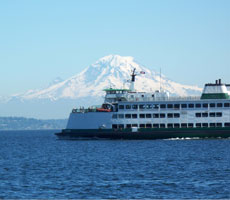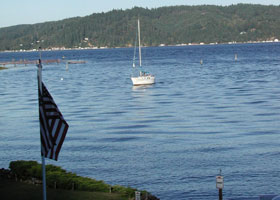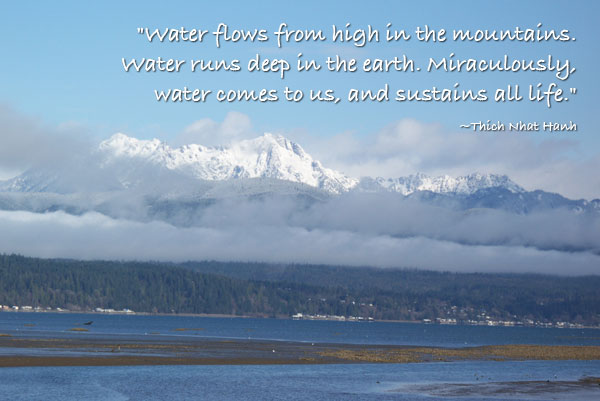|
The Hood Canal »
. . . . . . . . . . . . . . . . . . . . . . . . . . . . .
Simply known to locals as "the Hood," this magnificent 80+ mile body of saltwater is not a canal at all. It's actually a fijord carved from the earth 11,000 to 14,000 years ago by the scouring action of Canada's retreating Vashon Glacier.
According to local stories, some slow-thinking map maker years ago misspelled Hood Channel, and lo' Channel became Canal. And so that error has remained Canal ever since........
The Olympic Mountains towering over the west side of the Hood Canal well protect the waters from high winds and storms from the Pacific Ocean, unlike other unprotected waters in the Puget Sound region.
The shape of these mountains also causes a very moderate climate.

|
|
|
The Uniqueness »
. . . . . . . . . . . . . . . . . . . . . . . . . . . . . . . . . . .
What makes the Hood so unique is it's marine life which flourishes in the Hood's warmer waters. It's only currents are formed by the tides, and the inflow of several rivers like the Skokomish and the Duckabush, Hama Hama and Dosewallips Rivers.
These all combine to create a hydrosphere that allows shrimp, oysters, clams and crab to grow rapidly and abundantly. Add to this four salmon runs each year, and you have a most fascinating body of saltwater just a little over three miles from Skokomish Farms.
Many Hood Canal shore owners furnish fresh seafood to local buyers and markets. Shellfish companies like Taylor Shellfish in Shelton, Hunter Farm Store near Union and Patties in Potlatch maintain retail outlets where you can buy fresh oysters, shrimp, clams, and crab at very reasonable prices. Or start harvesting seafood on your own with an inexpensive Washington State license.

|
|
|
The Experience »
. . . . . . . . . . . . . . . . . . . . . . . . . . . .
The Hood Canal was originally populated by the Twana people. These Native Americans wintered in communal long houses on the Hood Canal.
In the summer, the families left the long houses, and setup individual family summer camps along the rivers feeding the Canal. Here they trapped the migrating fish for their food, and shared this abundance with others less fortunate.
When the British and Americans encroached onto the Hood, the Twana divided under pressure into separate tribes.
Today, only the Skokomish Tribal Nation calls the lower Hood Canal home. Other tribes migrated to different areas of the Puget Sound region.
Today, the Hood Canal is a myriad of active beach communities, small towns and villages which support fisheries, commercial farms, tourism, resorts, art colonies, state parks and a myriad of private homes.
You'll have miles and miles of waterways to explore in the Hood Canal region.
|
|

